Want to start a YouTube channel for fun and profit? Then you’re in the right place! There may be no better introduction to the world of YouTube marketing than this book. And here you’ll read a fast-paced, detailed summary of the best lessons in it!
Many of us remember YouTube as that website you could go to watch funny cat videos. Well, times have changed! Today it represents one of the greatest opportunities for making an impact and an income online. The investing company SignalFire estimates there are already over one million YouTubers making a six-figure income.
Creators are the new founders.
—SignalFire
Right away, this book tackles some top questions many of us may have like:
- Is it too late to get started? Nope, YouTube is a greater opportunity than ever. Right now it’s the dominant social media platform, with over 80% of U.S. adults using it daily. And it’s still growing, so there are plenty of hungry audiences still available for us to serve!
- Do you need a fancy camera? Nope, many of the most popular YouTubers got started with their smartphones—and you can too!
- What if you’re not a Hollywood actor? No acting skills required, you just need to be passionate and excited about a specific topic, whether that is cooking, beauty, technology, fitness, faith, movies, etc.
About the authors
Sean Cannell was making a six-figure income as a tech YouTuber for years, before starting his current multi-million dollar video education company. Now he is CEO of Think Media and host of the Think Media Podcast.
Benji Travis has created YouTube channels that have received over 1 billion views over the last 10 years. They include a popular cooking channel, as well as a family vlog channel with his wife.
Sean and Benji were both full-time YouTubers when they teamed to to write this book. But they wanted to test their ideas again starting from zero, so they created the channel Video Influencers that now has 660,000 subscribers. (Hey, maybe what they teach really works!)
🚀 1. Just Start: Take courageous action and begin your YouTube journey despite feeling judged, awkward, or alone
You know that scary feeling of diving into the unknown? That worry of “what if something bad happens?” Yeah, that feeling is real. And guess what? There’s really no way around it besides tacking our fears head-on. Just get started anyway, say Sean and Benji. While that may sound too simplistic, let’s unpack it.

- Fear of what people will think? The internet is a place full of all kinds of people, both wonderful and unkind. We have to accept that some hate comments are inevitable, no matter what we are doing. Even if we’re saving homeless kittens.
- Feel awkward in front of the camera? Every beginner YouTuber tends to feel a little weird when recording their first videos. Don’t believe me? Look up some of your favourite creators and find their earliest videos. That awkwardness only goes away over time with repetitions, once you have experience after publishing many videos.
- Feel alone or unsupported? Family and friends often won’t understand your goals, so it can be helpful to find a supportive community of people with likeminded goals, even if that is just an online group in the beginning.
Find your why. To help maintain courage in the face of our fears, it’s important to keep our reason why at the top of our minds. Why do you want to create a YouTube channel? Write down those reasons and review them whenever you’re feeling discouraged or unmotivated.
Some of your reasons may be related to personal goals, like making a certain income, sharing your passion, perhaps quitting your job. Other goals may be other-centred, like you want to connect with other people who share your passion and create videos that others find valuable or entertaining.
The slogan “Just Do It” comes from Nike, the #1 sports clothing brand in the world. Well, if you’re looking for inspiration to jump into your entrepreneurial journey, one of my favourites is the book “Shoe Dog,” which tells the life story of the founder of Nike.
Phil Knight was just a skinny college kid who loved running, but he had a “crazy idea” in college, to sell Japanese-made shoes in America. As a naive young person, basically still a kid, he flew to Japan and made a deal with a shoe company, not really knowing what he was doing. Then he flew back to the U.S. and started selling shoes from the back trunk of his car. Eventually that grew into Nike, the enormous brand we all know today.
To other ambitious young people, Phil says it’s always best to “start before you’re ready,” because if we try to work out all the details beforehand, then we’ll feel too intimidated and probably give up on our dreams. As a scared young man, he told himself, “Let everyone else call your idea crazy… just keep going. Don’t stop. Don’t even think about stopping until you get there, and don’t give much thought to where ‘there’ is. Whatever comes, just don’t stop.”
It’s completely normal to feel negative emotions before starting a YouTube channel. Fear of being judged and unsupported, or feelings of awkwardness or nervousness in front of the camera. The important thing is to “Just do it,” just get started because that is how the fears will slowly evaporate.
If we feel fear and nervousness before starting a YouTube channel, "YouTube Secrets" suggests that we .
Wait until fear subsides.
Practice meditation.
Just start; fears will diminish.
Improve video skills first.
🔍 2. Focus on One Passion: A narrow niche focus helps your channel gain a loyal audience much faster
Ever found yourself stuck at the beginning of your YouTube journey, watching other creators growing their channels, and asking yourself “What’s the perfect channel idea for me?” Well, then this section will help you find the right direction! The first thing you should know is that starting a successful YouTube channel is NOT about chasing every trend or trying to appeal to everyone…
Success on YouTube comes down to this simple formula: Pick a topic that aligns with your passion, your skills, and what the market wants.
Have you ever heard of the Japanese word Ikigai?
Some believe that people in Japan live longer and healthier than others because they have found their “ikigai”—which means having “a reason for being.” It is about having a purpose, a passion, or a powerful reason for getting up in the morning. We feel happier and probably live longer when we can do what we love, around people we love.
In the bestselling book Ikigai, the authors say we can determine our unique Ikigai by asking ourselves these three questions and seeing where our answers overlap:
- What do you love?
- What can you be great at?
- What will the market pay you for?
So, there we have the same idea told a different way, now let’s explore these concepts individually to see why it’s important to have all three—passion, ability, and market ability.
1. Passion
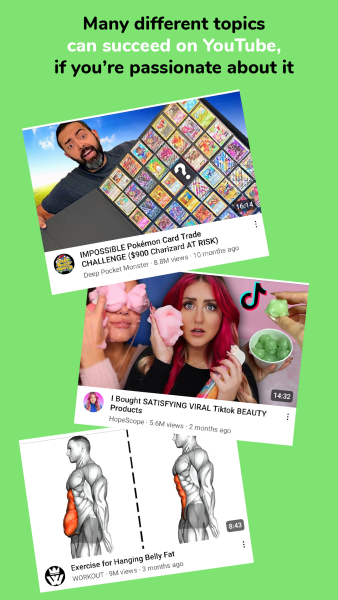
Passion is basically creating a channel on a topic that you feel excited about. But it’s far more than a fleeting temporary feeling. It’s a topic that you can feel deeply enthusiastic talking about, day after day, week after week, month after month. Even if your family members can’t understand your fascination.
Why is passion so important? Because in order to succeed on YouTube, you must maintain energy towards your channel. Sean and Benji repeat this four times, that YouTube is “a marathon, not a sprint.” A practical tip: They recommend publishing 30-50 videos BEFORE you judge how well you’re doing.
2. Skills
In YouTube Secrets they use the word “proficiency,” which simply means what you’re good at, either a skill you already have or something that you can reasonably expect to become great at. A good hint from me: pay attention to what activities put you into a state of “flow,” when time seems to disappear and hours go by without you noticing. Those activities you could probably become great or proficient at.
3. Market wants
There need to be enough people out there in the world/marketplace that want to hear about the topic. If you see somebody else already doing what you want to do, that’s not a reason to feel discouraged, but actually a great sign! It’s the best proof you can get that there are people interested in watching that kind of content! You just need to put your unique spin on the topic.
One great way to stand out from similar existing channels and gain traction faster is by NARROWING down your topic. Most of us think we’ll grow faster by going wider, but on the internet it’s the opposite—a narrow niche focus almost always wins, especially when you’re starting out. If other channels are already talking about “video games” then you could focus on “Nintendo video games” or even better “Super Mario video games.”
When it comes to online business and passive income, one teacher that I’ve been studying from for YEARS is Pat Flynn, host of the Smart Passive Income Podcast. His first online business was selling study guides for a specific exam that architect students needed to pass. Then he created a small empire, helping people launch their online businesses through courses, books, and plugins.
However, in the past couple years, Pat Flynn has created his most profitable project ever—a YouTube channel on Pokemon card collecting called “Deep Pocket Monsters”! He started it as a side project, partly because his kids also love Pokemon. But then something unexpected happened. The channel blew up to almost 700,000 subscribers and TENS of thousands of dollars per month!
That story really proves that in the world of the internet, passion trumps everything. And often the more narrow your focus is, the quicker you can gain traction online. The world of Pokemon card collecting looks completely incomprehensible to those outside of it—grown men spending thousands of dollars collecting colourful little pieces of cardboard. But as Pat Flynn himself wrote in his online business book Will It Fly?: “The truth is if you don’t have a passion for what you are doing, your energy will eventually fizzle out.”
Read more in our summary of Will It Fly? by Pat Flynn (coming in the future)
Build your YouTube channel around a passion—something you can feel enthusiastic about months and years into the future. This is how you can maintain motivation and succeed, because it is “a marathon, not a sprint.” Also, pick something you can be good at and there is a proven market for.
To maintain your motivation and enthusiasm, build your YouTube channel around a .
Popular trend
Personal passion
What seems profitable
Viral content
🎉 3. Your First 1,000 Fans: Cultivate your community through valuable content and genuine engagement
Dream of turning a YouTube channel into your full-time income someday? Then here’s some good news: you probably don’t need to have millions of subscribers or become the next Mr. Beast. In fact, your golden number may just be 1,000. That is to say, you may just need 1,000 true fans to build a sustainable, full-time income stream.
This idea comes from the investor and futurist Kevin Kelly, who wrote a famous essay called “1,000 True Fans.” Let’s break it down…
The simple math is that a creator could earn $100,000 per year income, if they have just 1,000 dedicated fans, each willing to contribute $100 per year.
Okay, that is still not exactly easy, but Kevin Kelly argues that for most people it is far more achievable than trying to get millions of followers. As an example, the biggest fans of a music artist are more than willing to spend $100 per year on event tickets, t-shirts, posters, etc. We’ll talk all about effective monetization methods in the next section…
Let’s talk about how to nurture those 1,000 true fans:
a) Clarify your unique value proposition
Every successful YouTube channel offers some kind of value, the reason why people come back to watching it again and again, such as: entertainment, education, inspiration, information, etc. Many of the most popular channels offer a combination of these, like combining education with funny jokes and memes. This forms the core value or reason why someone will come watch your channel and become a subscriber.
b) Set expectations with your brand identity
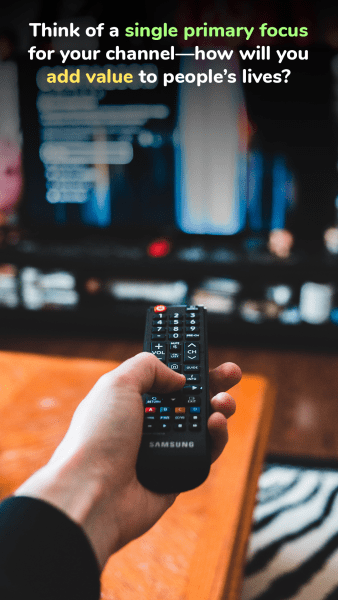
Why do most people subscribe to a YouTube channel? Because they just really enjoyed a video from that channel and want to see more like it in the future. So if you want to build subscribers faster, make sure people know what to expect from your channel going forward.
This is where a clear brand name can be so helpful. Think of it like TV channels—people know if they want history they go to The History Channel, while if they want sports they go to ESPN. A good example is Sean and Benji’s own channel, “Video Influencers” or the health-related channel “Nerd Fitness.”
But remember, while a catchy brand name is good, there is also power in using a personal brand, or your own name for your channel. Many popular creators go that route.
c) Encourage audience engagement
Finally, to build your 1,000 true fans faster, you must cultivate community engagement and interaction. Here are some key ideas:
- Ask for comments. At the end of each video, ask your viewers to answer a specific question. Reply to each comment that you’re able to, because interaction fosters loyalty.
- Cross-promote your other social media. When someone follow you on other platforms, they become a more dedicated fan, whether that is Facebook, Twitter, TikTok, etc.
- Nudge them to subscribe. The largest creators ask people to subscribe every single video. That may sound unnecessary, but clearly it’s the strategy that works! To avoid sounding like we are begging, you can say something like “Subscribe so you don’t miss out on future videos about xyz!”
One of the best books I’ve read about online business is Dotcom Secrets by Russell Brunson. His most important idea is that instead of building traditional websites, we should build sales funnels (also called marketing funnels).
What’s the difference? Simply put, a sales funnel has one single aim for each page, whether that is getting our visitor to click a specific link, sign up to our newsletter, or click that “add to cart” button. Every page contains a clear “call to action” telling them exactly what to do next. Brunson writes, “One of the fundamental rules of marketing is that ‘a confused mind always says no.”
Learn more about making money online in our summary of Dotcom Secrets by Russell Brunson
To make a full-time income, we may only need 1,000 true fans. To get there, we should clarify what type of value we will offer our audience (entertainment, education, etc.), then set expectations with a consistent brand, and actively encourage engagement by directly asking for comments and subscriptions in every single video.
For a successful YouTube channel, identify the type of to offer your audience.
Value
Product
Humor
Advertising
💰 4. Monetize Your Videos: 10 proven ways to make passive income, even with a smaller YouTube channel
Once we’re starting to get some views, how do we turn that into actual cash? Great news, you don’t need to be a mega-star with millions of subscribers to start making money. With the right strategies, even a relatively small channel can bring in a decent revenue stream.
Here’s a very quick overview of the 10 monetization methods discussed in YouTube Secrets:
- Adsense: Think of this as getting paid directly by YouTube, for allowing them to put ads on your videos. In many ways, this is the simplest and easiest way to start making money—to turn on this feature for your channel, you just need to hit 1,000 subscribers and a certain number of watched hours. But here’s the catch: you can expect to make about $2 per 1,000 views, so you’d need a whopping 1 million views monthly to make $2,000 per month. So, this strategy’s best for channels aiming to get tons of views, like those related to entertainment, comedy, news, vlogs, etc.
- Affiliate marketing: You can make sales commissions online, by sending people to purchase products at e-commerce websites. Typically, you’ll sign up to be an affiliate on a company’s website, such as Amazon, then they’ll provide you unique links. When people click those links under your videos, the company will know those customers came from you and reward you a sales commission, usually 1-10% depending on the type of product. Even with a smaller audience, you can make a significant amount of money, especially if your YouTube channel discusses specific products, like if it’s related to tech, beauty, fashion, finance, reviews, etc.
- Your own product or service: While it takes more upfront work to create your own products to sell, this is often where the real money is, especially if your channel isn’t reaching millions of people. You can sell anything from physical products like t-shirts and mugs (YouTube now integrates directly with platforms like Teespring and Amazon Merch). Or you can sell digital products like courses, ebooks, etc. Even higher priced services like coaching and consulting.
- Free product trade: Believe it or not, some companies are willing to send you their products for free, in exchange for a review or promotion on your channel. In essence, you’re trading your influence for goods. As they say, “a penny saved is a penny earned.”
- Generating leads: If you have an existing business, you can use YouTube as another way of getting leads and customers. Just think of what questions or topics that your potential customers would be searching for, then make videos addressing those topics. The co-author Benji built his local real estate business to 100 property deals per year, using this exact strategy.
- Crowdfunding: This is the most direct approach, asking your audience for funding. With YouTubers, the most popular way is using Patreon, which is built for ongoing monthly support through memberships. But you can also launch specific projects with sites like KickStarter, Indiegogo and GoFundMe.
- Events: You can organize events to connect in-person with your community. This includes everything from live performances by music artists to professional industry events. The author Sean Cannell organizes “Grow With Video Live” every year in Las Vegas, though during COVID it became a digital event.
- Brand sponsorships: This is also called a “brand deal,” getting paid to talk about a product in your videos. Instead of waiting for companies to notice you, you can take the initiative: reach out directly, use a middle agent, or find opportunities on marketplaces like AspireIQ. A massive subscriber count isn’t always necessary, especially if there is a close match between your audience and their product. For example, Heather Torres created a homeschooling channel with just 2,500 subscribers and was able to sign a partnership agreement with a company selling homeschooling curriculums to parents.
- Licensed content: Your video footage could be perfect for someone else’s purpose—think travel vloggers licensing their beautiful clips to tourism boards. The simplest way is to go the stock video route, uploading your best footage to websites where you’ll earn a fee if someone decides to use it in their project.
- Speaking engagements: Depending on your channel topic, you may begin receiving opportunities to speak landing in your inbox, as a side effect of building your personal brand and authority. Sean Cannell speaks many times per year at events on video marketing, not only earning thousands of dollars but also valuable networking opportunities.
Another must-read book for online business enthusiasts is “The Millionaire Fastlane” by MJ DeMarco. After trying numerous get-rich-quick schemes that didn’t work, DeMarco struck gold by setting up a limousine rental website—an idea he got while working as a limo driver. In his book, he shows us how to spot solid business ideas and avoid falling for fake ones.
A central idea of his is “The Profit Equation”: profit = scale x magnitude. To achieve remarkable profits, you can either influence a vast audience (scale), make a profound impact (magnitude), or ideally, both.
Take Mr. Beast, who entertains millions for a quick thrill—that’s scale. A heart surgeon, on the other hand, deeply affects a few by saving lives—that’s magnitude. Then there’s Elon Musk, selling $50,000 electric cars to millions—that’s harnessing both scale and magnitude, and that is why he is the world’s wealthiest man.
As a YouTube creator, there are many ways that you can get paid. Some of the best methods include: getting paid for ads, recommending products for a commission, selling your own items, teaming up with companies, and even speaking at events.
One popular way that YouTube creators make money is by , where they make a sales commission for recommending products from other companies like Amazon.
Advertising
Livestreaming
Affiliate marketing
Crowdfunding
🔁 5. Consistency is Key: Show up with a new video every week, by keeping things simple
Did you ever notice that your favourite YouTubers seem to come out with one or two new videos every week? That’s no coincidence. If someone wants to succeed on YouTube, one new video per week is probably the minimum you should aim for, advise Sean and Benji.
There are many powerful benefits to consistently uploading new videos:

- You’ll improve your skills. Just like any craft, the more you do it, the better you get. Take each new video as an opportunity to refine, experiment, and evolve. Just take a look at the earliest videos of your favourite YouTubers and you may be shocked at how amateur they look! That’s the power of tiny 1% improvements, repeated over and over again.
- You’ll build a relationship with your viewers. Just as in real life, the more often that people see your face and hear your voice, the more they will feel connected to you. They will begin to know, like and trust you, almost like their real life friends.
- Increase your odds of going viral. Consider each upload you make as buying a lottery ticket. The more tickets you have, the higher your chances of hitting the jackpot. It’s almost impossible to predict which one of your videos will “make it,” but by showing up each week, you maximize your odds.
Now I can almost hear some of you out there saying “But how do I keep up?” It’s no easy task, especially if you’re also balancing other responsibilities like work, study, family, etc. But here are some helpful tips, courtesy of Sean and Benji:
- Plan ahead. Draft an upload schedule and stick to it. Again, they advocate for at least one new video per week. The productivity teacher Brian Tracy offers a valuable tip that can help: Do your hardest task first thing in the morning—a strategy he calls “eating that frog!”
- Produce videos in batches. This is a brilliant idea. It’s kind of like meal prepping, but for content. Sean often films multiple videos in one long session, swapping his shirt to make the videos look different. They also record like a dozen podcast interviews during conferences, when many experts are available in that one location, giving them months’ worth of content.
- Simplify, simplify, simplify. We can often become overwhelmed believing that every video needs to be very well produced. But YouTube is often more about the connection between viewer and creator. Record some simple videos in one take, just talking into your smartphone camera, answering common questions. Or do a live video, allowing your viewers to chat with you in real time.
In The War of Art by Steven Pressfield, he describes how most creative people feel something called The Resistance—it’s an internal force that opposes our desire to create and pursue our calling. So, what’s the solution? We need to recognize that feeling of Resistance is not us, and sit down to work anyway, even if we don’t feel like it in the beginning, because that’s what Professionals do.
Read more in our summary of The War of Art by Steven Pressfield
A major secret to YouTube success is that consistency is key, that means uploading at least one new video per week. To do that more easily, make sure you schedule your video creation time, batch produce multiple videos at one time, and remember that simple videos are fine.
Benji and Travis recommend delivering at least to your audience.
1 new video per day
2 new videos per week
1 new video per month
1 new video per week
🎥 6. Creating the ‘Perfect’ Video: “Hacking” the YouTube algorithm to get maximum views in less time
So you want to “crush it” and “dominate” on YouTube? (To use the influencer way of speaking. 😆) Then you’ll need to understand the YouTube algorithm. Don’t worry, this is simpler than it sounds.
The YouTube algorithm is all about keeping viewers hooked on the platform. The longer they watch, the more ads YouTube can show, meaning more revenue for them.
Your mission? Have viewers click on and stick with your videos. Do that, and YouTube’s algorithm will boost your content. Here’s how—pay close attention to these metrics in your YouTube Studio dashboard:
- Clickthrough Rate: The percentage of people who click on your video, primarily influenced by your title and thumbnail. Make them irresistible, and YouTube will push your video higher on recommendations.
- Average View Time: This shows how captivating your video is. Longer watch times mean more ads shown and a signal to YouTube that your content isn’t just flashy clickbait.
- Average Views Per Viewer: If a viewer binges multiple of your videos in a row, it’s a high-five from YouTube indicating you’re on the right track.
So here are the most important ingredients of your video:

- Start with your title and thumbnail. Many top creators spend hours thinking of compelling ideas for their titles and thumbnails before filming anything. (So they don’t waste days making a video nobody wants to watch!) Analyze popular videos in your niche to find common patterns. For example, if your main competitors’ top videos spotlight their face, try doing that too.
- Hook/capture their attention immediately. Those first few seconds are crucial. To keep viewers engaged, plan your first sentence carefully, add some quick cuts, or give a teaser of what’s coming up later. Avoid the beginner’s mistake of a long rambling introduction about yourself.
(Pro tip: One of the best copywriting formulas I ever learned is to open with a “benefit + curiosity” hook. Like, “Have you ever wondered why do Japanese people live longer and stay thin?”) - Polish your core content. Experiment with different video lengths to find what works for you, from 5 minutes long to 1 hour or more. Mix in secondary footage, add humour, music, and sound effects. With every video, aim for a 1% improvement in on-camera confidence.
- End quickly. Once your core content finishes, people tend to stop watching, so end quickly. Guide viewers to another one of your videos with the feature called “end cards.”
Over 100 years ago, a legendary marketer named Claude Hopkins wrote an awesome book called Scientific Advertising. While he was writing newspaper ads back then, his tips continue to be surprisingly relevant today, for advertisers or content creators.
For example, Hopkins always spent 80% of his effort on writing the best headline possible, because he knew if the headline didn’t get the right reader’s attention, then the rest of the words wouldn’t matter!
Another great tip: always visualize one individual person in front of you and speak to them directly, not to a fuzzy mass of people—that works for writing or speaking on camera.
Learn more in our summary of Scientific Advertising by Claude Hopkins
To succeed on YouTube, you must play to its algorithm that prioritizes click-through rates, viewer retention, and viewer loyalty. Perfect your video creation by starting with captivating video titles and thumbnails, delivering a powerful hook, engaging core content, and wrapping up quickly with recommended videos.
What will HURT your chances in the YouTube algorithm?
Quick, engaging video cuts
A long rambling introduction
A compelling thumbnail
A benefit-driven headline
🚀 7. Scaling Up Your Channel: Leveraging advanced techniques and business building for even more growth
Finally, want to skyrocket your channel’s reach? In this final lesson, I’ll provide a brief overview of many topics covered in the final chapters of YouTube Secrets:
- Optimize for video search. YouTube isn’t just a video platform, many people are not aware that it’s also the second-largest search engine in the world after Google. So if you want sustainable growth in views and subscribers, it’s essential to optimize your content for search.
Start by identifying what users are searching for by looking at the pop-up predictions in YouTube’s search bar. You can also do more precise keyword research using tools—the authors recommend VidIQ.com. Make sure your video title and description match what people are actually searching for, and your video content truly answers their question or need. - Collaborate strategically. Collaborating with other creators is the “fastest way to grow” your channel, say Sean and Benji, aside from having a video go viral.
Start by finding other creators whose topic or audience overlaps with yours, using a spreadsheet to keep track of your outreach. If they don’t reply, try again every 3 to 6 months because people are simply busy. Even if you have a smaller channel, they may agree to an interview or joint video, because it helps them create another piece of content faster or is an opportunity to promote their new book, project, etc.

- Harness trends and holidays. You can get a quick boost in views by tapping into cultural trends and holidays—which are kind of like trends that repeat every year. If you want to take advantage of a new trend, then you’ll need to move fast because they can be over quickly—think of the Harlem Shake or fidget spinners, which were all the rage until everybody forgot about them.
To capitalize on holidays, begin planning a couple months in advance. A couple good examples: a cooking channel could feature a recipe for Thanksgiving or Valentine’s Day, while a tech channel could feature gift ideas for Christmas or Father’s Day. - Beware of social media. Before, Sean and Benji thought social media was essential, but now their opinion has changed, and they believe it’s often a huge distraction for new creators. They recommend we focus our energy deeply on YouTube, instead of spreading ourselves thin across many different social media platforms.
In the future, you may be able to hire a team like Gary Vaynerchuk, to transform each one of your videos into multiple shorter videos, images and posts for all kinds of platforms. That brings us to… - Building your team. Pretty much every very successful YouTube creator they know has some kind of team, so it’s something you’ll probably want to think about in the future as well. Even starting really small, hiring someone just 5 hours per week for part-time assistance, can make a significant difference. You can find freelancers on sites like Fiverr or Upwork, or by looking nearby. Like Sean found an intern in his church that wanted to learn how to do video editing, that is now one of his core staff members.
- Adapting to new features. Even after 16 years, YouTube continues to evolve rapidly, with new opportunities constantly emerging with features like short video, live streaming, stories, and the community tab. These authors agree with Gary Vee, who says we should spend 80% of our time doubling down on what’s working, and 20% on experimentation.
The biggest new opportunity is vertical short videos, a trend popularized by TikTok and now embraced by Instagram and YouTube. But while creating them might seem easier—sometimes directly from your phone—don’t mistake this for a shortcut to success. Top-performing YouTube Shorts creators prioritize both consistency and quality, often uploading as frequently as five times daily!
To scale up your channel, embrace a range of strategies. From optimizing your videos for what people are actively searching for, to collaborating with other creators, to harnessing the excitement generated by trends and holidays. Eventually you’ll want to experiment with new YouTube features like Shorts, build a team, and expand to other social media platforms—but don’t get distracted too soon!
To ensure sustainable YouTube growth, it's crucial to optimize your content for .
Video search
Social media trends
Maximum clicks
Ad revenue
- Begin Your YouTube Journey Today. Don’t wait for the perfect moment; it will never come. Sign up for a free YouTube account and upload a simple introduction video. Remember, the goal is progress, not perfection. Face those fears of judgment and awkwardness head-on by hitting “publish”.
- Optimize One Video. For your next upload, narrow your focus on a specific passion. Take notes on a few videos about your passion that are popular. Get inspired by their ideas, titles, and thumbnail design to create your own original video.
- Set a Consistent Schedule. Mark your calendar for a consistent day and time each week when you’ll upload your content. This not only trains your audience to anticipate your videos, but also instills discipline in your content creation process.

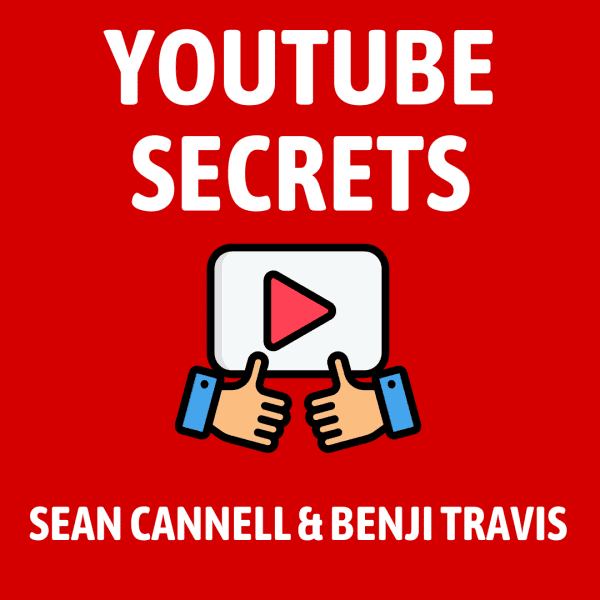


















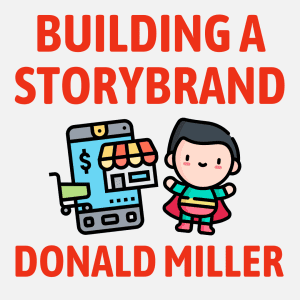
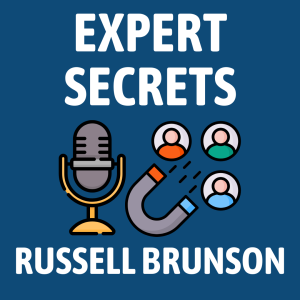


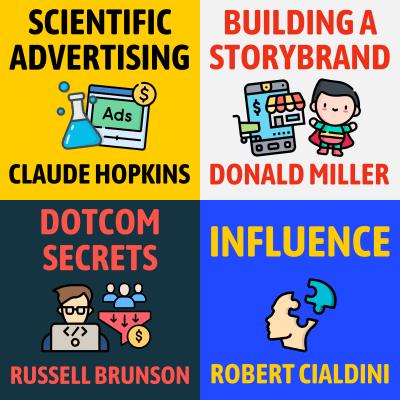
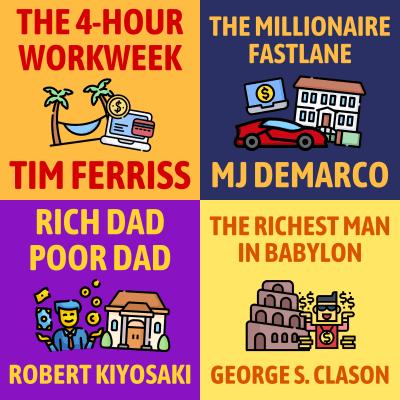


Community Notes